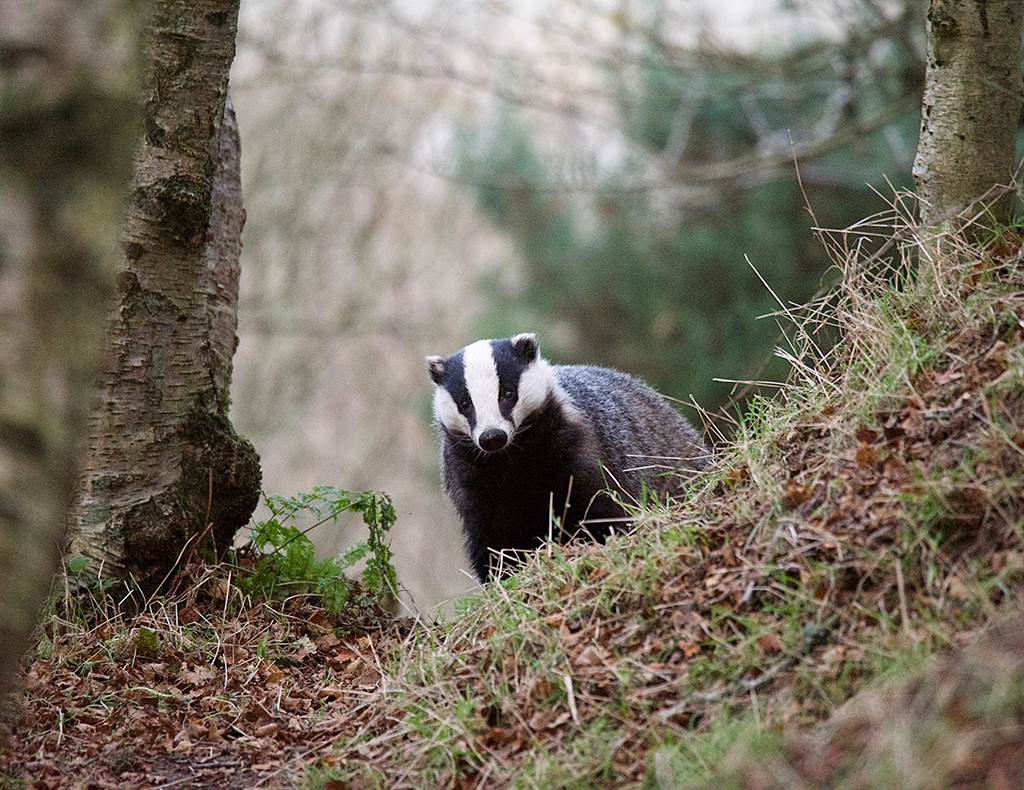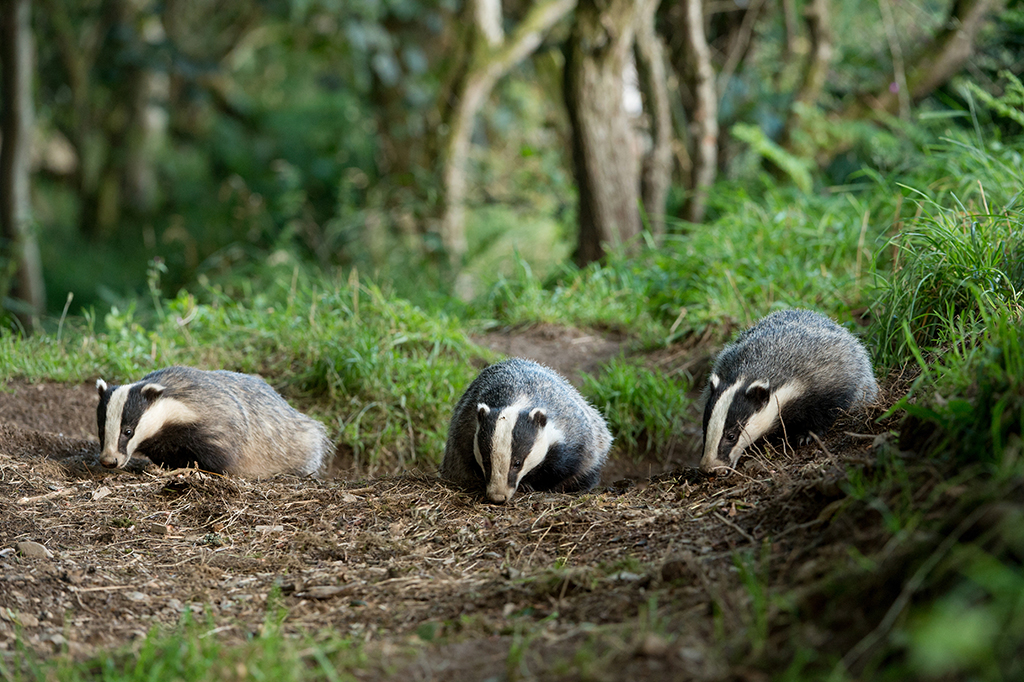Attacked on all sides, and the victim of government-sponsored culls as well as unimaginable brutality at the hands of criminal gangs, the badger faces a difficult future.
It’s a sunny afternoon in a bramble thicket deep in Perthshire woodland.
A robin appears and cocks his head in our direction, turning over the newly disturbed leaf litter with a quizzical look. Beside a mighty oak with gnarled and twisted bark, and a small burn running off the nearby hills, this is where the badgers have made their sett.
Deep scratch marks on a fallen branch lying across the burn are further evidence of an animal with immense digging capabilities. This oak tree has witnessed the comings and goings of countless generations of badgers – it’s an idyllic location, a textbook ‘badger place’, adjacent to rough pastureland that is perfect for nocturnal foraging. This peaceful, secluded hillside is laced with a labyrinth of tunnels – a typical badgers’ sett, with its spoil heaps of freshly dug earth, its soiled bedding pulled out, its tell-tale latrine pits.
Badgers have been here for decades. This is one of the lucky clans; countless others are under siege.
The charity Scottish Badgers co-operates closely with the Badger Trust, whose activities cover England and Wales. It promotes the study, conservation and protection of badgers in Scotland, their setts and natural habitat, and is keen to record as many setts as possible with the help of local knowledge, members and volunteers.
Both Scottish Badgers and the Badger Trust have grave concerns for the animals’ future. Not only are they opposed to the current English cull, they also have worries concerning a host of other threats, including one so horrific it almost defies belief.

All is far from well with Mr Brock. While this enigmatic member of the mustelid family is frequently voted as one of the country’s top three favourite mammals, it has an equally vocal number of haters. This ancient beast, said to have kept the company of the mammoth, now finds itself at the heart of one of the most heated and politically charged agriculture-versus-wildlife debates of all time.
Farmers are furious that the badger, as far as they can see, is the reason for so many of their cattle being infected by bovine tuberculosis. This is particularly so in South West England, the West Midlands and South Wales. Setts are sometimes bulldozed, particularly on arable ground where they muck up immaculate fields of grain, but largely because farmers have been persuaded that badgers spread this disease.
Few Scottish farmers appear to like badgers either. Yet here we have very different livestock laws, and are more stringent about cattle movements; and we do not have a problem. In September 2009, in fact, Scotland was officially declared free of bovine TB.
Badgers have been blamed for the spread of TB but the science is unclear, and with the trial cull in South West England now being extended, the situation looks set to worsen rather than improve.
Instead of solving the problem, it seems more likely that, in leading to badger clans becoming fragmented, the fleeing, fearful animals will
actually spread the disease all the more.
With the science being either ignored and confused or twisted to suit the political argument, a toxic cauldron of passion and venom is brewing, which does nothing to ease the worries of the beleaguered farming community.
Having myself witnessed the horrors of having all our cattle taken off the family farm in Angus when brucellosis forced their slaughter, and lived through several outbreaks of foot-and-mouth, and endured the farcical carry-on that was BSE when we had a mad Irish bulling heifer, I can relate to farmers’ desperation. TB is serious.
If the squeeze on finances continues to force farmers to employ such unnaturally intensive practices, solutions with wildlife will have to be reached that do not result in ineffective mass culls. One Cumbrian farmer boasted that blocking all the sett entrances on his land and then feeding a hose from his Land Rover’s exhaust pipe straight into the sett could rid him of badgers far more efficiently and painlessly. Many do exactly that.
The current cull is devastating, but the badger faces a far worse enemy. Badger baiting, a barbaric activity that has been outlawed since 1835, is once again rife in Scotland. Despite the ban, it never really stopped, with baiters travelling the length and breadth of the country in pursuit of their perverted pastime.
It’s big in the Central Belt but often gangs head further north to known setts; and no badger is safe when targeted by a gang and their specially bred dogs. Usually a quiet, playful animal, the badger is renowned for having the most powerful jaws of all mustelids, and when cornered it will defend itself with incredible force.

In some cases the animals are first captured and taken to an artificial sett with a fighting ring. Some of the hardest criminals in the country will congregate to watch the impending bloodbath and bet on its outcome; it’s all about having the hardest and bravest dog, and a good deal of money is said to change hands.
These fights are horrendous – eyewitnesses say they are so violent that they leave harrowing mental scars on anyone with even a remote concern for animals. A dog is put onto the badger and the fight begins as it hangs on for grim death and the animals start to tear each other to shreds.
Badgers are usually maimed beforehand to give the dog a better chance and ensure the fight lasts longer; teeth and claws may be pulled out, the jaw can be broken and the orbital ridge on the skull (which gives the badger great strength) is smashed with a spade. There are reports of badgers being nailed to the ground by the tail.
Sometimes fires are lit at the entrance to each sett except one; a dog is sent down to drive out the badgers while another waits outside to catch the terrified fleeing animals.
Any dog that does not hang on to the badger is considered useless, abandoned and left to die. Injured dogs are not taken to the vet, for obvious reasons, and some have been found with shocking burns and wounds.
The perpetrators are often known criminals with a track record of violence. Confronting them is not an option; there are disturbing tales of terrifying encounters. Bringing cases to book is notoriously difficult too, with the police ill-equipped to deal with the crime. Scottish Badgers believes raising awareness and more vigilance can help to eradicate it. Whether you see the badger as friend or foe, surely no true countryman would want to let this horrifying practice continue. It’s the stuff of nightmares; even researching it has left me deeply disturbed.
For more information or to make a donation, see www.scottishbadgers.org.uk.
- This feature was originally published in 2014.
TAGS

